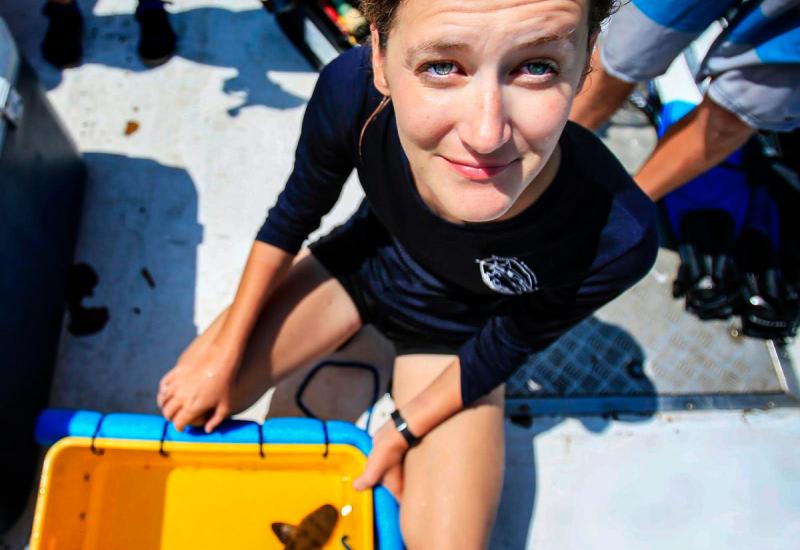Top Eight Citizen-Science Dives in the Florida Keys
In the Florida Keys, scuba diving and ocean conservation often go hand-in-hand. By diving in with local organizations as a citizen-scientist or volunteer diver, you contribute to cutting-edge science, help restore the environment with your own two hands and transform into an ambassador for change ‒ all while having fun and doing good. Here are a few of our favorite ways to “play with a purpose” in the Florida Keys:
CORAL RESTORATION
1. Coral Restoration Foundation (CRF) Dive Program, Key Largo

Courtesy Zach Ransom/Coral Restoration FoundationDivers use brushes to clean the CRF Coral Tree Nursery in Tavernier.
CRF’s dive programs throughout the Keys allow you to swim through the world’s largest in-water coral nursery, personally place critically endangered corals back onto the reef and surface with a sense of accomplishment. Sign up with CRF for an immersive, two-tank scuba or snuba experience.
For a deeper dive into the science, earn PADI’s Coral Restoration Distinctive Specialty through CRF’s two-day certification program.
2. Reef Revival by Mote Marine Laboratory, Looe Key

Courtesy Mote Marine LaboratoryMote's land-based nursery for growing corals.
Mote’s Reef Revival program reopens on Feb. 19, 2021. The elevated eco-tourism experience invites divers to a first-hand view of Mote’s science-based restoration efforts as well as the Looe Key underwater coral nursery. Help fragment actual corals and repopulate coral trees for future restoration before exploring existing outplants on Looe Key reef. Book a two-tank trip through Captain Hook’s (Big Pine).
Check back soon for non-diving ways to help and exciting, citizen-science programs on coral spawning (sexual reproduction).
3. Islamorada Conservation and Restoration Education (I.CARE), Islamorada

Courtesy Islamorada Conservation and Restoration EducationI.CARE’s first outplanting trip was a great success.
Starting Mar. 13, 2021, I.CARE will offer weekly public coral outplant trips through local dive shops. Morning education will include hands-on coral restoration science at the land-based Islamorada coral nursery. Two dives will follow, one to transplant up to seven coral species and the other for critical reef maintenance. You will boost coral survival and learn about the entire ecosystem by removing snails/algae, monitoring outplants and collecting critical data on reef fish and invertebrates. Check I.CARE’s schedule to join.
4. Reef Renewal USA (RRUSA), Tavernier, Marathon and Looe Key

Courtesy Michael Echevarria /Reef RenewalVolunteers add a tray of coral fragments to a nursery.
RRUSA engages volunteers to grow corals differently and outplant fast. Join RRUSA at one of their “pop-up” nurseries near outplant sites either by joining a partner dive shop for a two-tank trip or by bringing your own boat out. Outplanting will begin in Spring 2021.
Land volunteering opportunities are also available for non-divers. Contact Reef Renewal to find out more.
CLEANUP DIVES
5. Key Dives Cleanup Dives, Islamorada
Project Aware Dives Against Debris are the most direct way to give back. Take old rope, anchors, fishing traps and plastic off the reef to protect corals and marine animals from dangerous entanglements while diving and exploring.

Tiffany Duong/Ocean RebelsMarine debris removed are sorted and weighed after every dive.
Key Dives offers bi-monthly cleanup trips. Over the last two-and-a-half years, they’ve removed over six tons of debris from the ocean floor. Data about the organisms that come up with debris are used to understand the impact marine debris has on coral reefs and to refine removal methods. Contact Key Dives to request a cleanup trip.
Several dive shops throughout the Keys offer cleanup dives. For a full list, visit NOAA’s “Goal: Clean Seas Florida Keys” program page.
BIODIVERSITY
6. Reef Environmental Education Foundation (REEF), Key Largo

Tiffany Duong/ Ocean RebelsVolunteer divers use underwater slates and pencils to note what fish and animals they see underwater.
REEF’s Volunteer Fish Survey Project is the world’s largest marine life sightings database. Using an underwater slate and pencil, divers and snorkelers record all fish species they identify at a site. The data are uploaded to REEF’s extensive online database. With more than 265,000 fish surveys completed, the valuable database helps scientists and resource managers understand population fluctuations and potential threats to ocean health.
Surveys can be completed anytime online and during non-pandemic circumstances, REEF hosts public fish survey dives in Key Largo. Visit REEF to learn more.
7. Lionfish Eradication with Forever Young Charter Company and REEF, Islamorada and Key Largo

Courtesy Reef Environmental Education FoundationA diver holds invasive lionfish in a puncture-safe bag while diving.
Forever Young leads the Keys in lionfish eradication trips that combine conservation and hunting for a fun, new experience. Lionfish are invasive, venomous fish that decimate reef habitats by eating all the small benthic animals. You’ll learn about lionfish and the best ways to safely catch them on scuba, with a pole spear and zookeeper. All gear, training and permits are provided. To book, visit Forever Young.
Several times a year, REEF hosts lionfish derbies in the Keys. During these weekend-long spearfishing tournaments, divers compete to remove as many invasive lionfish as possible for prizes, and the festivals often close with music, art and lionfish cookouts. Data are used to assess relative abundance on local reefs and the extent of the invasion. In 12 years of derbies, 28,050 lionfish have been removed from the Keys. To sign up, visit REEF.
CORAL MONITORING
8. Southeast Florida Action Network (SEAFAN) BleachWatch and Stony Coral Tissue Loss Disease (SCTLD) Photo Tags

Courtesy Nikole Ordway/BleachWatchA submitted photo of a bleached coral from 2015.
If you see bleached corals or a yellow tag near a coral mound, take a picture and submit it to the official SEAFAN database. Scientists rely on citizen-scientists to be their eyes in the water. To request BleachWatch training, fill out this survey. Submit SEAFAN reports online. For SCTLD, which is a devastating coral disease, photos are used to evaluate treatments and to activate response teams. Submit photos of tagged coral colonies to SEAFAN.










